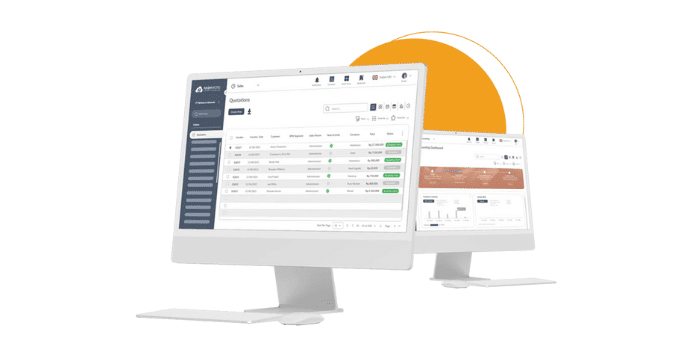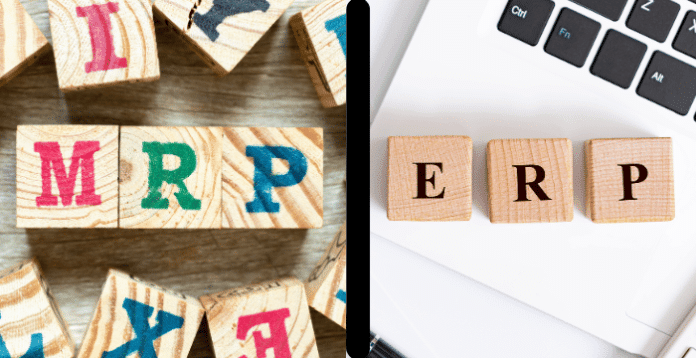In today’s rapidly evolving business landscape, the need for efficient supply chain management becomes more crucial. Companies are constantly seeking ways to streamline their operations and gain a competitive edge. This is where MRP vs ERP systems come into play. These two systems are designed to help businesses manage their inventory, production, and supply chain processes effectively.
While MRP and ERP share some similarities in their functionality, they are distinct systems with different capabilities and purposes. In this article, we will delve deeper into the difference between MRP vs ERP, helping businesses make informed decisions about which one aligns best with their unique needs and objectives.
Table of Content:
Table of Content

What is an MRP System?
Material Requirements Planning (MRP) is a stand-alone solution that helps businesses manage their inventory and production processes. It involves the systematic planning and control of materials required for production, ensuring that the right quantities of raw materials needed are available at the right time. By analyzing factors such as lead times, order quantities, and production schedules, MRP enables businesses to plan their manufacturing operations effectively.
MRP Key Features
By harnessing the power of technology and data analysis, the MRP system offers a comprehensive framework. The system comes with a range of features that revolutionize the way businesses manage their materials and production activities. Here are some of its key features:
- Bill of Materials (BOM): MRP utilizes a bill of materials, which is a comprehensive list of components and raw materials required to produce a finished product. The BOM defines the structure and hierarchy of the product, specifying the quantity of each item needed.
- Inventory Control: MRP helps in maintaining optimal inventory levels by considering the demand for finished products and current inventory levels. It calculates the number of materials needed and determines when to reorder or produce them to avoid stockouts or excess inventory.
- Production Planning: This feature facilitates the scheduling and coordination of production activities. It aims to optimize resource allocation, labor utilization, and machine capacities to meet the projected demand while maintaining efficiency and reducing costs.
- Demand Forecasting: It estimates future customer demand for a product or service. By analyzing historical sales data, market trends, and customer insights, MRP systems can generate forecasts that serve as the foundation for effective material planning.
Benefits of MRP

Material Requirements Planning (MRP) offers numerous industry-specific benefits in today’s dynamic marketplace. From efficient inventory management to increased labor productivity and improved production planning, MRP empowers enterprises to enhance their production efficiency.
Manage inventory efficiently
One of the significant benefits of MRP is its ability to manage inventory efficiently, which is crucial for certain industries like manufacturing and Supply Chain Management (SCM). The system enables businesses to accurately calculate the optimal inventory levels required to meet production demands while minimizing excess stock. Efficient inventory management through MRP has several advantages.
MRP prevents overstocking, reducing the carrying costs associated with excess inventory. This leads to improved cash flow and reduced storage expenses. It also ensures that the necessary materials are available, preventing stockouts and associated production delays. By optimizing inventory levels, MRP helps strike a balance between maintaining an adequate supply to meet customer demands and avoiding unnecessary holding costs.
Increase labor productivity
MRP contributes to increasing labor productivity within a company. By providing accurate and timely information about material requirements, MRP allows production teams to plan and schedule their work effectively. With a clear understanding of the materials, employees can optimize their time and efforts, focusing on value-added activities rather than wasting time searching for materials or waiting for supplies to arrive.
Furthermore, the system reduces idle time and enables employees to work more efficiently, improving overall labor productivity. By streamlining material availability and enabling effective planning, MRP empowers employees to make the most of their skills and efforts, leading to increased output and improved operational efficiency.
Improve production planning
Effective production planning is crucial for optimizing resource utilization. MRP plays a vital role in improving production planning processes. By analyzing the bill of materials, current inventory levels, and production schedules, MRP provides insights into the material requirements and timelines necessary to fulfill customer orders.
With MRP, businesses can accurately determine the lead times and dependencies associated with each production order. This enables efficient sequencing of production activities, minimizing bottlenecks. Additionally, it helps identify potential constraints in the production process. As a result, they can take proactive measures to address these issues in advance.
Definition of ERP

What is ERP? It stands for Enterprise Resource Planning, a system designed to help businesses manage their entire supply chain, from sales and finance to inventory and production. ERP was first introduced in the 1990s and has since become a standard tool for businesses. It is widely used by a wide range of industries requiring a comprehensive system to manage their operations. This includes retail, manufacturing, and F&B.
The system integrates various business functions and departments into a single system, providing real-time visibility into operations. Not only that, it also automates business operations. Moreover, some ERP systems are customizable to meet the specific needs of the business.
ERP Key Features

Enterprise Resource Planning provides businesses with a centralized platform that offers a wide range of modules. Common modules include accounting, manufacturing HRM, and procurement. Additionally, the system is equipped with a comprehensive suite of features that span across different functional areas. Below are some of the key features of an ERP system:
- Scalability and Flexibility: ERP aims to accommodate the growth and changing needs of businesses. They offer scalability and flexibility, allowing organizations to add or modify modules, users, and functionalities as their requirements evolve over time.
- Reporting and Analytics: The system provides reporting and analytics capabilities, allowing businesses to generate custom reports, dashboards, and key performance indicators (KPIs). These features provide actionable insights, facilitating data-driven decision-making. As a result, companies can monitor and improve their performance across different functions.
- Customer Relationship Management (CRM): This feature allows businesses to track sales leads, automate marketing campaigns, and provide better customer service. Moreover, integration with sales and marketing modules enables a holistic view of customer data, further enhancing customer relationship management and enabling personalized marketing efforts.
- Human Resources Management (HRM): ERP typically includes HR management modules that cover various HR functions. For instance, employee records, payroll, performance management, and training. One ERP system that offers HRM is Hash Core ERP. These features simplify HR processes, improve employee engagement, and ensure compliance with labor laws and regulations.
Benefits of ERP
The Enterprise Resource Planning (ERP) system has emerged as an indispensable tool for businesses, providing a multitude of benefits that can transform how businesses function. From boosting efficiency to saving costs, ERP solutions have the potential to drive sustainable growth. Here are some benefits that companies can reap from implementing an ERP system:
Boost overall efficiency
An ERP system eliminates the need for multiple standalone software solutions by integrating various functions. In addition, it automates repetitive and time-consuming tasks, such as order processing. These abilities streamline processes, reduce manual data entry, and minimize errors. As a result, employees can work more efficiently.
ERP also provides real-time visibility into key business data, allowing employees to access accurate information whenever needed. This real-time access enables faster decision-making, improves responsiveness to customer demands, and facilitates proactive management of business operations.
Enhance collaboration
An ERP system enables the integration of workflows across various departments, improving cross-functional collaboration. For example, sales and production teams can collaborate more effectively when they have real-time visibility into inventory levels, production schedules, and customer orders. This allows them to align their activities efficiently.
It can also facilitate collaboration with external stakeholders, such as suppliers, distributors, and customers. By sharing relevant data and streamlining communication channels, ERP systems improve coordination and enhance relationships. This further leads to improved supply chain management and customer satisfaction.
Save costs
ERP systems can help businesses achieve significant cost savings by optimizing processes, reducing waste, and improving resource utilization. ERP systems offer robust financial management capabilities, including budgeting, forecasting, and financial reporting. These features enable businesses to gain better control over their finances, identify cost-saving opportunities, and make informed decisions that contribute to long-term profitability.
Also Read: Top ERP Software Recommendations – Explore the best software options available this year and find the right fit for your business needs.
Differences Between MRP vs ERP Systems
While both serve as valuable tools for managing resources and optimizing processes, they differ in scope, users, costs, and the level of integration they offer. Understanding these key differences is crucial for organizations seeking to implement the most suitable system for their specific needs, then what is the difference between MRP vs ERP?
Scope
The main difference between MRP and ERP is the scope of the system. MRP is focused solely on managing inventory and production planning. It provides tools for tracking inventory levels, and managing production schedules. On the other hand, ERP is a comprehensive system that integrates various business functions into a single system, such as customer relationship management.
Users
MRP vs ERP systems caters to different user groups within an organization. MRP is primarily used by manufacturing and production personnel, including production planners, inventory managers, and procurement teams. In contrast, ERP supports users across various departments and functional areas, for instance, sales and marketing teams. The system provides role-based access, enabling different users to access and utilize relevant information based on their responsibilities and permissions.
Integration capabilities
Integration capability refers to the ability of a system to connect and share data with other systems within and outside the company. MRP typically focuses on integrating with other systems within the manufacturing environment, such as inventory control systems, and procurement software.
Meanwhile, ERP is known for its extensive integration capabilities. They can integrate with various internal and external systems, such as HR systems. This integration allows for seamless data flow across different departments.
Costs
Cost is another important factor to consider when comparing MRP vs ERP. MRP systems are generally less expensive than ERP systems. They are designed for smaller businesses with more limited needs and budgets. ERP systems, on the other hand, are typically more expensive due to their complexity and the need for customization.
Conclusion
Both MRP and ERP are powerful software solutions that play crucial roles in managing and optimizing business operations. While MRP focuses primarily on business production, ERP offers a broader scope, encompassing various functions like sales and human resources. Therefore, the choice between MRP vs ERP depends on the specific needs and complexity of a business. However, ERP provides more value and can help businesses streamline their operations in ways that MRP systems cannot.
For small to medium-sized enterprises looking for a comprehensive and scalable solution, ERP emerges as the ideal choice. One such exemplary ERP system is HashMicro’s Hash Core ERP which combines robust features and ease of use. With its advanced modules and seamless integration, the cloud-based system empowers businesses to achieve long-term success. You can start HashMicro’s Core ERP Software demo for free now.


































